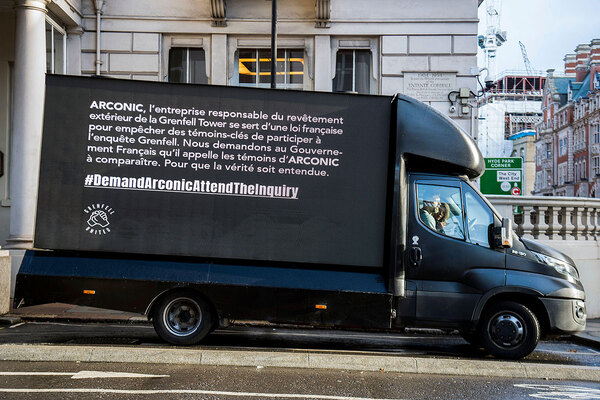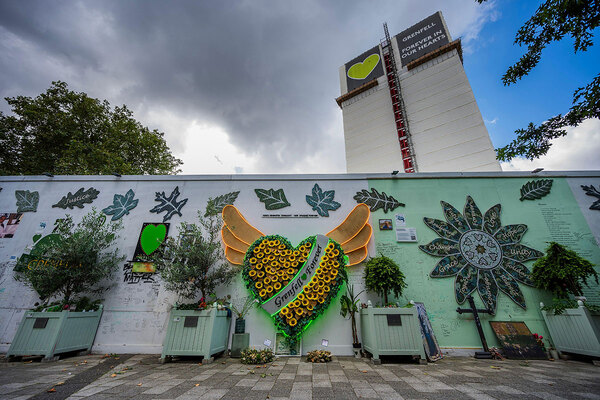The Grenfell Tower Inquiry report may not have made recommendations to social landlords, but it is still a major call for change
Today’s Grenfell Tower Inquiry report surprisingly stopped short of making recommendations for social housing providers. But it did ask them to read it and reflect. This is homework which should be taken seriously, writes Peter Apps
“Others responsible for the management of social housing should give them careful consideration and take appropriate action accordingly.”
The Grenfell Tower Inquiry may not have made recommendations directly impacting the work of social housing providers – deeming recent regulatory changes sufficient to drive change – but it did set homework.
Specifically, Sir Martin Moore-Bick, the chair of the inquiry, has told you (if you are one our many readers who works at a social landlord) to read the criticisms of the Kensington and Chelsea Tenant Management Organisation (KCTMO) and Kensington and Chelsea Council contained in Parts 4 and 5 of his report, reflect on them carefully and act. For ease, you can find those sections here.
So what should the sector make of them?
The first task is to read them in the right frame of mind. An adjective the report repeats several times with regard to KCTMO is “defensive”.
It responded to criticism from its residents and local councillors with “defensiveness and hostility”, the report says, and as such missed opportunities to correct its mistakes.
There is a danger of this report being read in a similar way by those who work in this sector. Isn’t this really a story about the failure of central government? Or the “systematic dishonesty” of big corporations? Or the “cavalier attitude” of the architects? Is this really a story about social landlords failing at all?
Weren’t these perfectly normal social housing providers, caught up in a much bigger construction sector scandal?
That is an attitude I’ve heard expressed from time to time over the years. But it’s a dangerous fallacy, and one which will block us from making the changes social housing residents need to see. The report sets out why.
To flag just some of the points raised, KCTMO was castigated for receiving two reports on major fire safety issues in its organisation in 2010 and 2013, and not only failing to act on them, but failing to tell the board about the criticisms which had been levelled.
This “was a very serious failing” on the part of Robert Black, chief executive of KCTMO at the time, the report said, adding that it showed neither he nor Janice Wray, head of health and safety at the organisation, “regarded fire safety as a high priority”.
“Mr Black’s failure to bring [these reports] to the attention of the board meant that there was no pressure on him to take action. His own failure to take responsibility for implementing the recommendations and put in place a strategy for solving the myriad of deficiencies in the management system was a further serious failing on his part,” it said.
KCTMO then appointed a fire risk assessor who was “ill-qualified to carry out fire risk assessments of buildings on this scale, let alone the entire... portfolio”. It did so because it wanted someone who would “take its side against the [London Fire Brigade (LFB)] when debating its fire safety requirements”, and because he was the cheapest. His work was “thoughtless, lazy and careless”, with Ms Wray failing to “read the fire risk assessments with any degree of care”, which again “reflected the [tenant management organisation’s (TMO’s)] casual approach to fire safety”.
Senior staff at the TMO, including Peter Maddison, director of assets, then put the fire risk assessor, Carl Stokes, under pressure to downgrade his rating of a problem with self-closing devices on fire doors to “strong advice” and to remove the colour-coding that would have marked it as urgent. It did this knowing it was under pressure from the LFB to reduce its burden of outstanding high-priority risks.
The report was highly critical of this. “Its behaviour in seeking to challenge and dilute Mr Stokes’s risk assessment… suggests that the TMO treated the demands of managing fire safety as an inconvenience rather than an essential aspect of its care for those living in the buildings under its management. It was a betrayal of its statutory obligations to its tenants,” it said.
And this mattered. The chronic failure of fire door self-closers in Grenfell Tower has already been found to have been a major cause of the loss of internal compartmentation and the rapid spread of smoke into communal lobbies, which itself has been found to have been a major event in preventing residents from fleeing immediately when they realised the building was on fire, which was a major cause of many of the deaths.
Setting all this out, reading it plainly and soberly, leads us to the conclusion we need to reach. These failings came from a casual attitude towards safety and a culture of defensiveness, and they had serious consequences. That is the attitude the sector must leave behind when it reads this report.
But the criticism of the social landlord is wider than this, spreading into the relationship it shared with the residents of the homes it managed.
Overall, it allowed its relationship with its residents to be “characterised by distrust, dislike, personal antagonism and anger”, with “some, perhaps many, occupants of Grenfell Tower” coming to view it “as an uncaring and bullying overlord, which belittled and marginalised them”.
These are tough words, but social landlords must reflect on them. Do your residents view you in the same light? If so, why?
The report places the onus on the social landlord: “Responsibility for the maintenance of the relationship between the TMO and the Grenfell community fell not on the members of that community, who had a right to be treated with respect, but on the TMO as a public body exercising control over the building which contained their homes.”
So, if similar distrust and dissatisfaction exist where you work, the report’s view is that it is your organisation that must reach out and find a way to fix it, not to retreat into warring camps.
Over the years, I have read several witness statements written by Grenfell residents who “engaged” – to use that frustrating sector term – with their landlord regularly in the years before the fire.
The emails they received back spell out in black and white the way it can feel to deal with an organisation like KCTMO. They were high-handed, dismissive, couched in the language of process and officialdom and unresponsive to legitimate concerns.
“However irritating and inconvenient it may at times have found the complaints and demands of some of the residents of Grenfell Tower, for the TMO to have allowed the relationship to deteriorate to such an extent reflects a serious failure on its part to observe its basic responsibilities,” the report says.
Pin that on the wall of the call centre if you have to. It is a lesson everyone who works in social housing must always remember.
Other sections of the report should also be brought to the attention of those responsible for social housing.
Read the sections on the aftermath of the fire, and ask if your emergency housing plans are up to scratch.
Then read the section on the official statutory advice about managing blocks of flats in force before Grenfell, and still largely applicable today. This said it was not necessary to provide for the needs of disabled people. The report’s view on it starts from page 227 here.
Consider that this guidance was written with a great deal of input from housing sector leaders, but none whatsoever from disabled residents. Then ask if we are really getting the balance right when we develop new policies impacting people’s lives.
All of these lessons are ones to take forward if we are serious about change.
I’ll end with a cautionary tale. After the Lakanal House fire in 2009, and the inquest in 2013, a small ALMO which had a number of high-rise buildings in its portfolio looked at the coroner’s recommendations and realised they would entail changes, some of them significant, if made mandatory.
So the organisation emailed government officials – privately – and asked whether they intended to implement what the coroner had suggested. They were reassured that they did not. “Initial indications from [the Department for Communities and Local Government] are that these recommendations are unlikely to be taken up” and “will not become mandatory”, an internal document said.
The organisation breathed a sigh of relief and did nothing.
You’ve probably guessed by now, but that organisation was KCTMO. I bet the people responsible wish they could have their time again and respond to the Lakanal House coroner’s inquest differently. Those who lost loved ones at Grenfell doubtless wish it even more.
So here we are again. Another report into another fire asks the sector to change, but does not make its requirements mandatory. Will we respond differently this time? That’s up to you.
Pete Apps, contributing editor, Inside Housing
All Inside Housing’s breaking stories on the Grenfell Inquiry Phase 2 report
KCTMO responsible for ‘chronic and systemic’ safety failings before Grenfell fire, inquiry concludes
Grenfell’s social housing provider was responsible for “chronic and systemic failings” in fire safety management, as well as a “toxic” relationship with the tower’s residents, who came to regard it as an “uncaring and bullying overlord that belittled and marginalised them”
Failed by ‘incompetence, calculated dishonesty, and greed’: reactions to Grenfell Tower Inquiry report
Inside Housing is highlighting responses to the second and final Grenfell Tower Inquiry report
The Grenfell Tower Inquiry report may not have made recommendations to social landlords, but it is still a major call for change
Today’s Grenfell Tower Inquiry report surprisingly stopped short of making recommendations for social housing providers. But it did ask them to read it and reflect. This is homework which should be taken seriously, writes Peter Apps
Grenfell Inquiry report elects not to make specific recommendations for social housing providers
The Grenfell Tower Inquiry has made no fresh recommendations for social landlords in its long-awaited Phase 2 report, saying recent legal changes are sufficient to drive reform
‘Complacent’ government ‘well aware’ of cladding risks before Grenfell fire but ‘failed to act’
A “poorly run”, “complacent” and “defensive” government department “failed to act on what it knew” about dangerous cladding in the years before Grenfell, amid an enthusiasm for deregulation which “dominated” its thinking
‘Systematic dishonesty’ by product manufacturers ‘very significant reason’ for Grenfell’s deadly cladding, inquiry concludes
“Systematic dishonesty” by product manufacturers was a “very significant reason” why Grenfell Tower was clad in such dangerous materials, the inquiry report into the fire has concluded
Social landlords must be ‘held to account’ for safety of homes, prime minister says
Sir Keir Starmer has pledged to make sure social landlords are “held to account” for the safety of the homes they provide, in a statement following the publication of the Grenfell Tower Inquiry’s second and final report
Sign up for our fire safety newsletter
Already have an account? Click here to manage your newsletters













